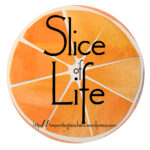SOL18: The Slice That Inspired a Slice
Posted on March 18th, 2018

“Green Reverse, Green 9, Green 5, Wild.” Confused, I scanned the next few lines. “Red 8, Red 2, Blue 2, Wild.”
Is this code? I wonder, and continue on down the page. Then I spot the word Uno.
Isn’t that a card game? If it is indeed a game, the word Uno must be good because it’s followed by an exclamation point. And Wild Blue 8 must be REALLY good because it merits a happy face. Could it be because the writer had the blue 8?
But then I come to “Crouch! Blind! Set!”
Hmmm….I’m thinking by now it must be a game being played. I could confirm my supposition by opening a new browser tab and pasting in the words. Oops…I see now that the title reads, “A Day of Games.”
That’s when it hits me.
I’m up in front of my second period Junior English, where we’ve just read one of Emily Dickinson’s poems.
“Miss, this doesn’t make any sense.”
I remind them it’s OK to look up any unfamiliar words.
“That doesn’t help! I know what the words mean, but I still don’t get it.”
By this point in the year, we’ve discussed how authors join larger, ongoing conversations with the world through their writing. As a reminder of that thought, we read together Dickinson’s poem “This is my letter to the world, That never wrote to me.”
“If this is one of Emily Dickinson’s letters to the world,” I ask, “what is she trying to tell us who never wrote to her?”
That’s when we begin the work of trying to understand the poem’s context, perspective, point of view, poetic techniques—skills that will help reveal the poem’s meaning. Hope flickers within me that they will remember to view literature they read as an author’s conversation with them. And being a conversation implies that the author expects a response from the reader.
So, even though it’s a only small slice of writing, I open my browser determined to understand the meaning of the words on the web page so that I can respond.

I’m a bit confused…were you reading a student’s code language based on the game of Uno?
I was reading Kristi’s Slice “A Day of Games” (http://imwritingtoo.blogspot.com/2018/03/a-day-of-games.html
I couldn’t make sense of it at first, and it reminded me of when I taught poetry to high school students, and so I transitioned to that memory. The last sentence indicates that I will check the Internet so that I can respond to her post.
Wow! To be in the company of Emily Dickinson. 🙂 I love how the brain makes connections and how teachers are always finding paths into furthering student learning. Did they help you figure out “Crouch! Blind! Set! Try!”?
Yes! I guessed rugby because of the word “try,” though. The Internet just confirmed it, and now I know three more rugby terms. 🙂
Love the change up…thought I knew where this was going. Well done! Keep working with them. It takes time.
So many connections…to the other slicer, to your students. I like it!
I love how you drew us in with a game that was probably familiar, but then also went to the unfamiliar . . . just what our students experience a lot! 🙂
I confess, I want to see the original slice! I am so bad at puzzles, not the word kind—usually—and I look up “crouch, bind, set” to find it’s connection to a rugby scrum. I love that you use metaphor this way, but I am dying to read the original post. Is it from a slice you read today? Great post!
Thanks, Patricia. I linked to Kristi’s post with her post’s title, but it may be hard to tell on your device. Here is the link: http://imwritingtoo.blogspot.com/2018/03/a-day-of-games.html
what a great slice. I love making connections in reading challenging writing. thanks for sharing.
I love that there is a connection between what you experience and what your students experience. I think sometimes people don’t want to take the time to understand the vocabulary they don’t understand. Kudos to you.
I like this slice, a lot. The writing works like a puzzle, mirroring the subject matter. Well done.